
Courtland is a town in Lawrence County, Alabama, United States, and is included in the Decatur Metropolitan Area, as well as the Huntsville-Decatur Combined Statistical Area. The population was 609 at the 2010 census, down from 769 in 2000.
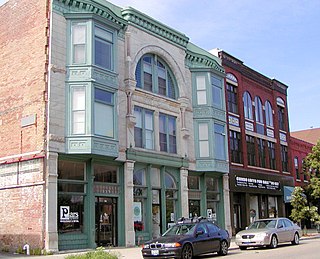
The Bloomington Central Business District is a historic district in downtown Bloomington, Illinois. The district includes roughly twelve square blocks of the city and encompasses 140 buildings, 118 of which are contributing buildings to the district's historic character. The 1901 McLean County Courthouse, the center of government of McLean County, is the focal point of the district. The other buildings in the district were built between 1842 and 1942 and are primarily commercial. The Miller-Davis Law Buildings, two of the oldest buildings in the district, were built in 1843 and represent the early period of Bloomington's development. Bloomington's commercial core grew rapidly during the 1850s and 1860s after two railroads opened in the city; while the 1854 Gridley Bank is the only surviving pre-1857 building from this period, several more remain from the later part of the boom. The city continued to grow, and its business district continued to expand, from 1860 until 1900; however, a fire destroyed much of its downtown in 1900. Several buildings in the district date from the rebuilding period of the early 1900s.

The Galena Historic District is a historic district located in the city of Galena, Illinois, USA. The historic district encompasses 85 percent of the city of Galena and includes more than 800 properties. The downtown area consists of three successive tiers made up of Main, Bench and Prospect Streets. Within the boundaries of the district are such notable homes as the Ulysses S. Grant Home and the Elihu B. Washburne House. The Galena Historic District was added to the U.S. National Register of Historic Places in 1969.

Tifton Commercial Historic District, in Tifton in Tift County, Georgia, is a historic district that was listed on the National Register of Historic Places (NRHP) in 1986 and expanded in 1994. The original listing was portions of 10 blocks including buildings from the 1890s to the late 1930s, most built of brick.

There are nine historic districts in Meridian, Mississippi. Each of these districts is listed on the National Register of Historic Places. One district, Meridian Downtown Historic District, is a combination of two older districts, Meridian Urban Center Historic District and Union Station Historic District. Many architectural styles are present in the districts, most from the late 19th century and early 20th century, including Queen Anne, Colonial Revival, Italianate, Art Deco, Late Victorian, and Bungalow.

The Greenwich Avenue Historic District is a historic district representing the commercial and civic historical development of the downtown area of the town of Greenwich, Connecticut. The district was listed on the National Register of Historic Places on August 31, 1989. Included in the district is the Greenwich Municipal Center Historic District, which was listed on the National Register the year before for the classical revival style municipal buildings in the core of Downtown. Most of the commercial buildings in the district fall into three broad styles, reflecting the period in which they were built: Italianate, Georgian Revival, and Commercial style. The district is linear and runs north–south along the entire length of Greenwich Avenue, the main thoroughfare of Downtown Greenwich, between U.S. Route 1 and the New Haven Line railroad tracks.

The Fayette County Courthouse Historic District is a historic district covering the downtown central business district of Fayette, Alabama. The majority of the buildings in the district were constructed soon after a fire destroyed the town in 1911; the architectural styles reflect common styles in commercial buildings around the Southern United States at the beginning of the 20th century. The district was listed on the National Register of Historic Places in 1976, and the boundaries of the district were increased in 2014.

The Madison Station Historic District is a historic district in Madison, Alabama. Madison was first settled around 1818 as a farming community, but significant growth began in 1858, when the first depot was built along the Memphis and Charleston Railroad line. Madison Station became an important loading point for the shipment of cotton, supplanting the Tennessee River as the preferred means of shipment. Merchants and other businesses soon followed, with many people moving from the river port of Triana. After a lull during the Civil War, the town's growth continued; Madison was incorporated in 1869. The town grew steadily until the 1950s, when industry spurred by the expansion of Redstone Arsenal replaced cotton as the primary economic force in Madison County.

The Fort Payne Main Street Historic District is a historic district in Fort Payne, Alabama. Centered on the intersection of Gault Avenue and 1st Street, the district contains commercial and public buildings that date from Fort Payne's second period of growth from the 1920s to World War II. Buildings from the first wave of development in the 1880s and 1890s are centered in the Fort Payne Boom Town Historic District to the northeast. Most of the commercial buildings are in a simple, utilitarian brick style. The later civic buildings exhibit more decorated styles, including the Classical Revival Post Office, and the Art Moderne City Hall (1941) and DeKalb County Activities Building (1941). The district was listed on the National Register of Historic Places in 1989.

The Alabama City Wall Street Historic District is a historic district in Gadsden, Alabama. Wall Street was the main commercial street in the town of Alabama City. The city was founded in 1891 halfway between Gadsden and Attalla, with intentions of becoming the major industrial hub of Northeast Alabama. In 1895 the town landed its first major concern, a cotton mill built by the Dwight Manufacturing Company of Chicopee, Massachusetts. Its second major factory, the Alabama Steel and Wire Company, was opened in 1902. By 1915, a thriving commercial district had grown up around 7th Avenue, which became known as "Little Wall Street". A fire in 1927 damaged or destroyed many structures along Wall Street and Meighan Avenue. The city would never recover from the loss, especially as neighboring Gadsden flourished; Alabama City voted to merge into Gadsden in 1932. The architecture of the district represent the changing commercial styles of the 1910s through the 1930s. Most are constructed in simple, brick styles with parapet roofs, some with more decorative brickwork. Art Deco-influenced features such as terra cotta coping and glass tile accents are present on later buildings. Other notable buildings are an Art Deco fire station and the Classical Revival library. The district was listed on the National Register of Historic Places in 2002.

The Attalla Downtown Historic District is a historic district in Attalla, Alabama. The city was founded in 1870 along the Alabama and Chattanooga Railroad. It quickly developed into a major iron ore export hub. After fires in 1887 and 1891, most of the frame buildings downtown were replaced with brick structures. The oldest buildings in the district, which date from the 1880s and 1890s, are built in Folk Victorian styles, with corbelled cornices and other decorative elements. Later buildings are in more plain Commercial Brick styles, while others were built in more academic styles, including the Art Moderne Etowah Theatre and the Colonial Revival Post Office building. The district was listed on the Alabama Register of Landmarks and Heritage in 2011 and the National Register of Historic Places in 2013.
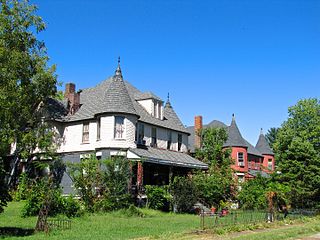
The Bridgeport Historic District is a historic district in Bridgeport, Alabama. Founded in the 1810s as a farming community, Bridgeport became a major transportation hub with the coming of the Nashville and Chattanooga Railroad and Southern Railway in the 1850s, in addition to its Tennessee River port. Due to the importance of its rail bridge, the town changed hands several times during the course of the Civil War. Industry began to move into the area in the late 1880s and 1890s, and commercial development of the downtown area soon followed. The district retains several one- and two-story commercial buildings, most constructed out of brick in simple styles popular in the late 19th and early 20th centuries. Many of the elite built their homes on Battery Hill, overlooking the river. The district contains several Victorian and Queen Anne houses, as well as Bungalows and Vernacular styles. The Mission Revival Nashville, Chattanooga, and St. Louis Railroad depot, three railroad bridges, and three Civil War fortifications are also contained in the district. The district was listed on the National Register of Historic Places in 2002.

The Public Square Historic District is a historic district in Scottsboro, Alabama. Although Scottsboro had been the county seat of Jackson County since 1870, the town's earliest commercial development was centered on the Memphis and Charleston Railroad line, one block north of the square. After an 1881 fire along the rail line, some businesses began to rebuild around the square. Once the Tennessee Valley Authority brought prosperity to the region in the 1930s, development around the courthouse began to accelerate. The current Jackson County Courthouse was built in 1912 with matching Classical Revival porticos on two sides. Commercial buildings around the square are one or two stories and all of brick. While most are built in simple, lightly decorated commercial styles, some late 19th-century buildings have Victorian detailing. The district was listed on the Alabama Register of Landmarks and Heritage in 1981 and the National Register of Historic Places in 1982.

The Hartselle Downtown Commercial Historic District is a historic district in Hartselle, Alabama. The town was founded in 1870 when the Louisville and Nashville Railroad was extended south to Birmingham and Mobile. Hartselle quickly grew into a transportation hub for shipping timber and cotton. The town was devastated by two fires, in 1901 which destroyed all commercial buildings east of the railroad tracks, and in 1916 where twenty-one buildings including the passenger and freight depots were destroyed. Only nine buildings survived the 1916 fire. After an initial building boom from 1916 through 1920, development slowed due to low farming prices after World War I and the Great Depression. Notable structures in the district are the hip roofed L&N passenger depot and two-story freight depot and the Colonial Revival post office. Of the commercial buildings, 51 are one story, 14 are two stories, and 1 is three stories. The district was listed on the National Register of Historic Places in 1999.
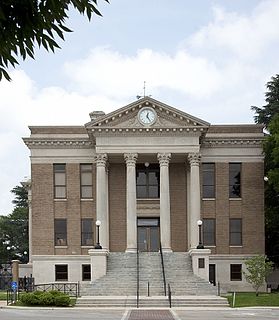
The Athens Courthouse Square Commercial Historic District is a historic district in Athens, Alabama. Athens was founded in 1818 when Robert Beaty and John D. Carroll began selling tracts of land. The following year, the town was chosen as the county seat of the newly formed Limestone County. Commercial development around the courthouse square was swift, aided by the strong cotton market. The town and courthouse suffered heavy damage during the Civil War in the Battle of Sulphur Creek Trestle. Athens' revival was slowed by major fires in 1882, 1894, and 1897, as well as the Panic of 1893. Redevelopment was spurred again in the 1910s and 1920s by a diversified economy with increased manufacturing, and in the 1930s by electricity provided by the Tennessee Valley Authority. Notable buildings in the district are the Limestone County Courthouse, built in 1919 in Neoclassical style with Palladian influences. The Old Post Office building was completed in 1933. The district was listed on the National Register of Historic Places in 1997 and the Alabama Register of Landmarks and Heritage in 2012.
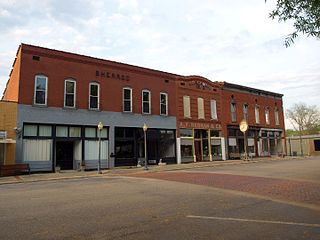
The Courtland Historic District is a historic district in Courtland, Alabama. Courtland was founded in 1818 and incorporated the following year. Its location was chosen to be close to the Tennessee River to facilitate transportation, but also close to cotton plantations to the south. The town's founders envisioned becoming the county seat of the newly formed Lawrence County, but the title instead went to Moulton. Many of the earliest structures in Courtland were built of logs, and were later replaced with frame and brick buildings. Development plateaued by 1830, but received a slight bump from the Tuscumbia, Courtland and Decatur Railroad beginning in 1834. The oldest houses in the district date from this era, including the 1828 Federal-style John McMahon House and several I-houses.

Stiefelmeyer's is a historic commercial building in Cullman, Alabama. The store was founded in 1888, and occupied a two-story frame storehouse until it was destroyed by fire in 1892. Although brick had already become the material of choice for commercial buildings in the town, the current Stiefelmeyer's was built in 1892 of wood. An addition was constructed in 1900, expanding the building to its current size. As other wood commercial buildings were destroyed by fire and replaced with brick structures, Stiefelmeyer's remains the only example of the once-dominant building material in Cullman's commercial district.

The Main Street Commercial District is a historic district in Dothan, Alabama. The district covers 18 acres and portions of 6 blocks in Dothan's historic commercial district. At the time of the nomination, it contained 68 contributing properties, however many have been demolished in the intervening years.
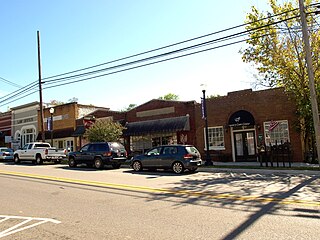
The Springville Historic District is a historic district in Springville, Alabama. The area around the "Big Spring" remained sparsely populated from 1814, when the land was ceded to the United States by the Creek Nation, until after the Civil War. A post office was established in 1834, and a sawmill was founded in 1861, but development did not begin in earnest until the coming of the Alabama and Chattanooga Railroad in 1870. Now connected to Atlanta and Columbus, Mississippi, business and industry began to center in Springville, and the town was a center for moving ore from the surrounding hills to industrial centers in Birmingham and Tuscaloosa.

The Waterloo East Commercial Historic District is a nationally recognized historic district located in Waterloo, Iowa, United States. It was listed on the National Register of Historic Places in 2011. At the time of its nomination the district consisted of 36 resources, including 28 contributing buildings, and eight non-contributing buildings. The city of Waterloo was established in the early 1850s. Its first settlers started developing the west side of the city before crossing the Cedar River and developing east side. The first Black Hawk County Courthouse was built on the east side in 1856 and East Waterloo Township was created two years later. As industry began to develop along the river, and the arrival of the first railroad in 1861, the commercial district on the east side began to grow. Also on the east side of town was the terminus of the streetcar-turned-interurban system. By 1900, the city became one of the primary wholesale and retail centers in northeastern Iowa. In 1911 the Black population increased significantly as workers, primarily from Mississippi, moved into town to work for the Illinois Central Railroad. The following year the saloons in town were closed and bootlegging, gambling, drugs, and prostitution started to increase in the area surrounding the central business district. All of these developed put together created the atmosphere of the downtown commercial district.























